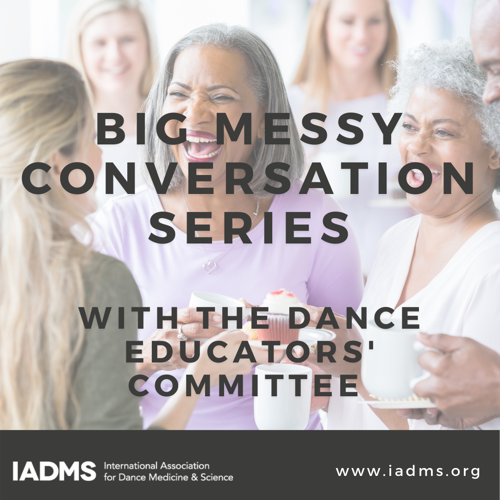Dance Educators' Committee: Big Messy Conversation Series
Author: Ellie Kusner on behalf of the IADMS Dance Educators' Committee
Dance science is a still nascent, but rapidly growing field that has permeated many spheres of dance education. However, dance science is a broad term without an agreed upon definition. In a traditional, higher education setting, it may include courses such as kinesiology, somatics, anatomy, dancer wellness, and various conditioning modalities each taught by professionals with a range of qualifications from professional certificate, to MFA, MSc, ATC, DPT, or PhD. At these same institutions, and in other settings, such as local studios or elite training programs, dance science education also encompases a variety of other modalities, like injury prevention or nutrition lectures presented by medical professionals, coaching sessions in a clinical setting, or dance technique classes rooted in a safe-practice and infused with evidenced-based methodologies. All of these are Dance Science Education.
Since its inception, dance science has evolved and transformed to meet the developing needs of dancers. When Sally Fitt wrote her seminal text, for example, the term “Dance Science” was yet to be born so she aligned her work with Kinesiologists. Student knowledge is ever increasing and interests are changing. Today, some mature student dancers are already familiar with the term “dance science” and many young students often know basic concepts of good alignment, but many gaps still remain. Student dancers and even professionals often know little about cross training protocols or the basics of performance anxiety, for example, but they are hungry for multidisciplinary information about nutrition, conditioning, psychology, neuroscience, and more. In addressing these topics, dance science possesses the power to excite young artists both intellectually and physically. However, some students are discouraged when they don't see themselves or their interests reflected and represented in the existing literature. This disappointment inspires a few to get involved and help shape the field, but too many others choose instead to pursue other interests and we lose out on potentially important perspectives that could inform our field and voices that could enrich our community.
Presently, it seems as though dance science is on the brink of a major transition from emerging adolescent to poised young adult. A global pandemic continues to force much of dance education into the virtual sphere; concurrently, struggles for social justice, social uprisings in many parts of the globe, and political extremism all share space in our daily lives. The confluence of these events invites introspection, and we’ve heard a number of our colleagues express a need for dialogue and a desire to restructure, reimagine, and reflect on aspects of dance science education. In acknowledgement of where we are now and what might come next, the Dance Educators’ Committee presents: BIG MESSY CONVERSATIONS: Where is Dance Science Education going in 2021, and beyond?
The IADMS Dance Educators' Committee invites you to attend all four of these big messy conversations over the next few months, but each can also be enjoyed a la carte! To assure a vibrant discussion, space is limited and pre-registration is required. The first 18 seats will be reserved for IADMS members.
Our first conversation, “How Did We Get Here?” is intended to reflect on the historical roots of dance science education and how dance science educators and students might restructure, reimagine, and reenvision its future.
How did dance science and dance science education first develop? Who were the key players? Who's contributions may have been overlooked? How has it evolved, and where might we go next?
Click HERE to sign up for this first webinar of the series, to be held Sunday, April 25 at 9:00am ET on Zoom.
